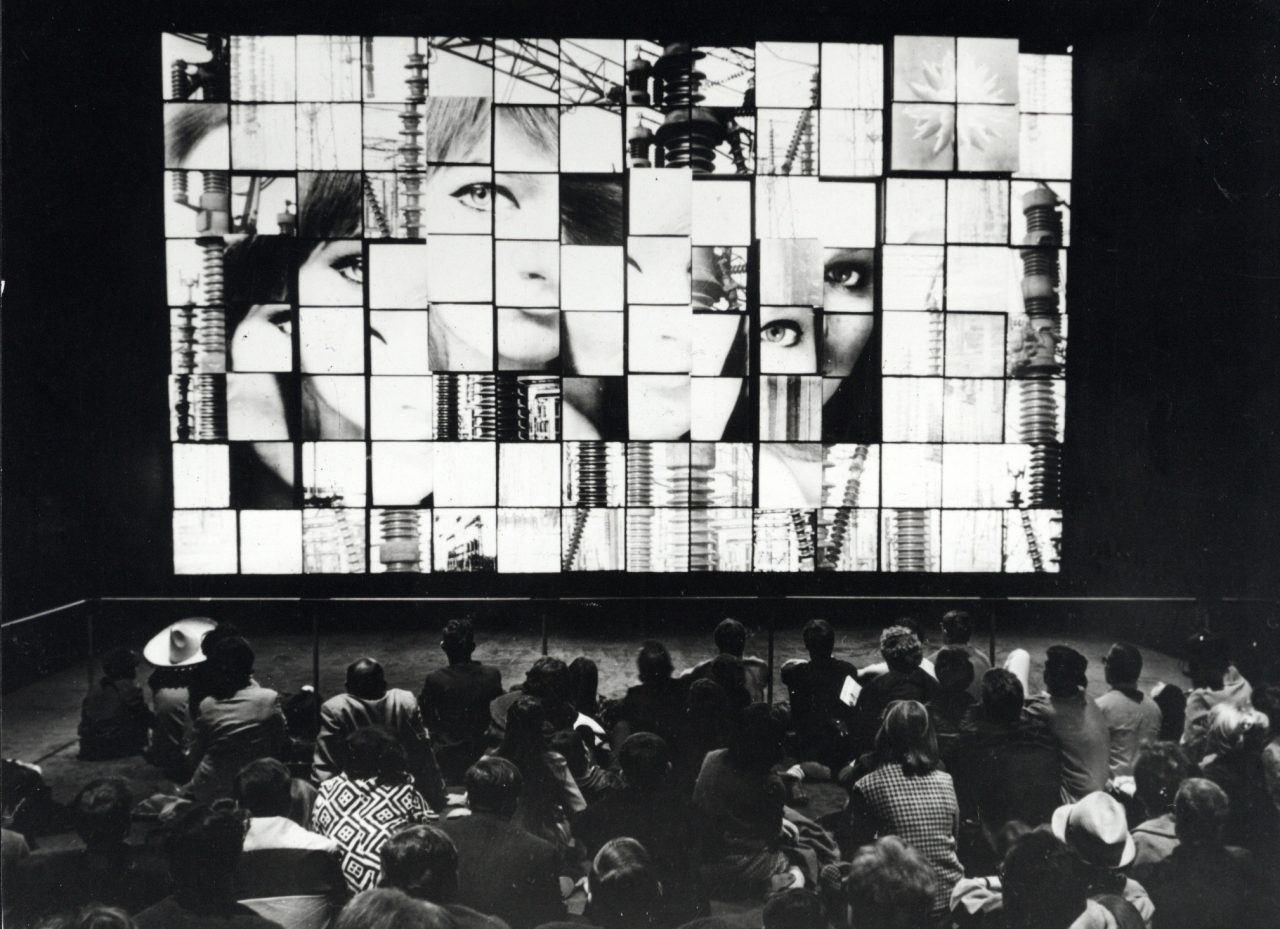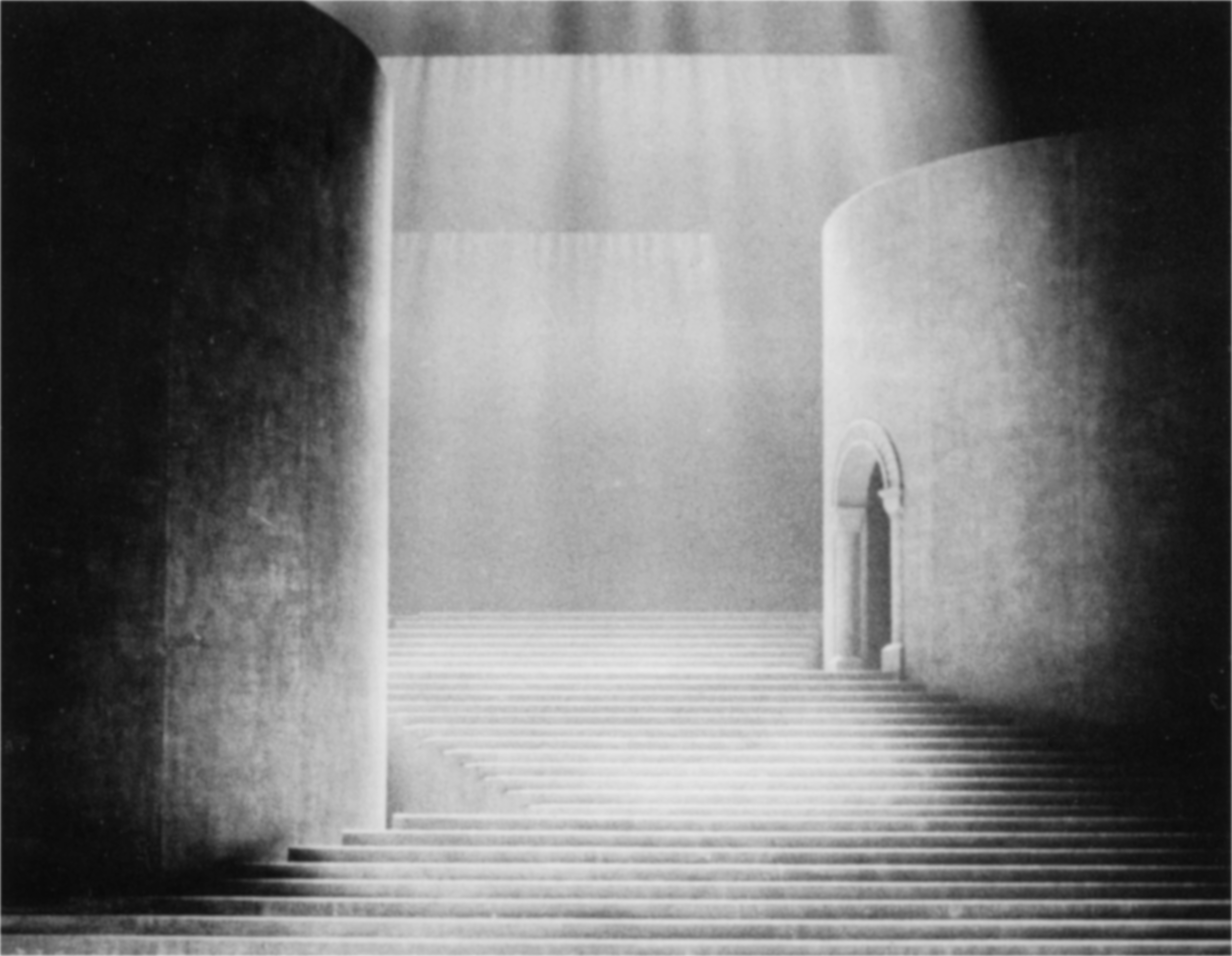Difference between revisions of "Architectures of Space and Image"
(Created page with "''Experimental performance-makers in the late 20th century responded to the advent of new media (television, video, computers, the internet) with many innovations in how they...") |
|||
| (One intermediate revision by the same user not shown) | |||
| Line 1: | Line 1: | ||
| − | '' | + | ''The Czech designer Josef Svoboda developed an anti-illusionist approach to stage design, placing light, projection and film at the centre of his designs. He co-founded the Laterna Magika multimedia theatre, and devised the multiscreen Diapolyekran.'' |
| − | + | [[File:IO2 B.08 1a.jpg|300px|thumb|left|DiaPolyekran, EXPO 67, Montreal]] | |
| + | |||
| + | By the middle of the 20th century, the technologies of electric stage lighting and projection were well developed, and those of video images (television) were emerging. The technical means were available for a radical new approach to the staging of performances, fulfilling the ambitions of earlier theatre theorists and practitioners such as [[Item:Q249|Adolphe Appia]] (Q249) and [[Item:Q325|Edward Gordon Craig]] (Q325) – a theatre of light, space and image. | ||
| − | + | The Czech stage designer [[Item:Q91|Josef Svoboda]] (Q91) joined the [[Item:Q12648|National Theatre in Prague]] (Q12648) in 1948, where he developed his rigorous approach to scenography. For Svoboda, each production was a unique puzzle to solve, to find the ideal solution to the staging of the performance. He worked closely with technicians to find unique solutions to his design requirements – even to the point of having a member of the stage staff collect eggshells from the breakfast serving at a nearby hotel, as the shells provided the ideal texture to light onto, on a piece of scenery. | |
| − | + | Svoboda developed techniques of using narrow beams of light to create spatial architectures in the air – the curtains of backlight creating Mediterranean heat for Verdi’s ''Sicilian Vespers'', and the spiral of rising beams for Wagner’s ''Tristan and Isolde''. [[Item:Q13146|Lighting fixtures]] were created specially to make these effects, but were soon put in production for commercial sale, such was their success (Q13146). Svoboda developed his use of physical materials on stage with light in mind – gauzes, steel mesh, tensioned cords, mirrors and transparent plastics were surfaces to take light and projected images. [[Item:Q3189|Beamlights]] (Q3189), using intense, low-voltage lamps provided soft-edged follow-spots that could highlight the performers anywhere on stage, without compromising the remainder of the lighting and the projection. | |
| − | + | In the National Theatre in Prague, there was enough dust in the air to make the beams of light visible, but when productions transferred to other, cleaner theatres, Svoboda worked with technologists to develop a system that sprayed very fine water droplets. The droplets were statically charged, and so remained suspended in the air, until the charge was reversed and the droplets fell to the stage, ‘magically’ clearing the air. | |
| − | + | [[File:IO2 B.08 4.jpg|300px|thumb|right|Sicilian Vespers, Metropolitan Opera, New York, 1974]] | |
| + | |||
| + | For Svoboda, the scenography must function dramatically, as a part of the evolving action. Dynamics were therefore very important to his work, sometimes involving complex stage mechanics. The fluidity of light and image, however, were vital to delivering this philosophy. | ||
| − | + | In 1958 Svoboda worked with the theatre director [[Item:Q30556|Alfréd Radok]] (Q30556), his brother [[Item:Q30557|Emil]] (Q30557), and scriptwriter [[Item:Q30558|Miloš Forman]] (Q30558) to create [[Item:Q16340|Laterna Magika]] (Q16340) to promote Czechoslovakian culture at the international exhibition Expo 58. The project combined film with live stage action on a multi-screen projection system, and has been claimed as the first multimedia theatre. From its start in 1958, Laterna Magika developed into a permanent theatre company, with Svoboda taking the role of artistic director in 1973. The company is still operating today, making new productions as well as performing older works. | |
| + | |||
| + | The concept of Laterna Magika was to find ways to create a theatre that synthesises all the elements, able to tell a story using a greater variety of means, especially through multimedia projection combined with the work of live performers on stage. The basic principle, the interactive integration of film projection with movement and acting, has gradually been complemented by new technologies such as digital projection or new media including real-time programmable software. Since the beginning, Laterna Magika’s productions have combined genres: drama, dance, pantomime and [[Item:Q3165|black-light theatre]] (Q3165). Each performance has a different way of combining stage and image, but the fundamental principle remains: the projection is not just a moving backdrop, nor does it merely create the appearance of reality. The action on the stage is always closely linked to the action on the screen. | ||
| + | |||
| + | Svoboda also created other multimedia systems. These technological experiments were developed for exhibitions, but the results were often subsequently used in the field of theatre. These systems used multiple screens or three-dimensional objects as projection surfaces for still and moving images; combined with a recorded musical score, the result was an audio-visual composition without live performers. Polyekran (literally, ‘multi-screen’) was presented at the EXPO 58 in Brussels at the same time as Laterna Magika, and had eight projection screens. Polyvision and Diapolyekran were both created for the 1967 EXPO in Montreal. Polyvision used three-dimensional, moving scenic elements on which the images were projected, while the Diapolyekran system had 112 independently rotating screens. These installations made a lasting impact on narrative cinema, video art and interactivity. | ||
| + | |||
| + | Svoboda led the development of an approach to both scenography and dramaturgy that uses architectures of space, light and image as its primary medium. Building on the theories and experiments of earlier 20th century innovators, he demonstrated how the newest theatre technologies could be harnessed in the service of the arts of performance. | ||
Latest revision as of 18:28, 18 February 2023
The Czech designer Josef Svoboda developed an anti-illusionist approach to stage design, placing light, projection and film at the centre of his designs. He co-founded the Laterna Magika multimedia theatre, and devised the multiscreen Diapolyekran.
By the middle of the 20th century, the technologies of electric stage lighting and projection were well developed, and those of video images (television) were emerging. The technical means were available for a radical new approach to the staging of performances, fulfilling the ambitions of earlier theatre theorists and practitioners such as Adolphe Appia (Q249) and Edward Gordon Craig (Q325) – a theatre of light, space and image.
The Czech stage designer Josef Svoboda (Q91) joined the National Theatre in Prague (Q12648) in 1948, where he developed his rigorous approach to scenography. For Svoboda, each production was a unique puzzle to solve, to find the ideal solution to the staging of the performance. He worked closely with technicians to find unique solutions to his design requirements – even to the point of having a member of the stage staff collect eggshells from the breakfast serving at a nearby hotel, as the shells provided the ideal texture to light onto, on a piece of scenery.
Svoboda developed techniques of using narrow beams of light to create spatial architectures in the air – the curtains of backlight creating Mediterranean heat for Verdi’s Sicilian Vespers, and the spiral of rising beams for Wagner’s Tristan and Isolde. Lighting fixtures were created specially to make these effects, but were soon put in production for commercial sale, such was their success (Q13146). Svoboda developed his use of physical materials on stage with light in mind – gauzes, steel mesh, tensioned cords, mirrors and transparent plastics were surfaces to take light and projected images. Beamlights (Q3189), using intense, low-voltage lamps provided soft-edged follow-spots that could highlight the performers anywhere on stage, without compromising the remainder of the lighting and the projection.
In the National Theatre in Prague, there was enough dust in the air to make the beams of light visible, but when productions transferred to other, cleaner theatres, Svoboda worked with technologists to develop a system that sprayed very fine water droplets. The droplets were statically charged, and so remained suspended in the air, until the charge was reversed and the droplets fell to the stage, ‘magically’ clearing the air.
For Svoboda, the scenography must function dramatically, as a part of the evolving action. Dynamics were therefore very important to his work, sometimes involving complex stage mechanics. The fluidity of light and image, however, were vital to delivering this philosophy.
In 1958 Svoboda worked with the theatre director Alfréd Radok (Q30556), his brother Emil (Q30557), and scriptwriter Miloš Forman (Q30558) to create Laterna Magika (Q16340) to promote Czechoslovakian culture at the international exhibition Expo 58. The project combined film with live stage action on a multi-screen projection system, and has been claimed as the first multimedia theatre. From its start in 1958, Laterna Magika developed into a permanent theatre company, with Svoboda taking the role of artistic director in 1973. The company is still operating today, making new productions as well as performing older works.
The concept of Laterna Magika was to find ways to create a theatre that synthesises all the elements, able to tell a story using a greater variety of means, especially through multimedia projection combined with the work of live performers on stage. The basic principle, the interactive integration of film projection with movement and acting, has gradually been complemented by new technologies such as digital projection or new media including real-time programmable software. Since the beginning, Laterna Magika’s productions have combined genres: drama, dance, pantomime and black-light theatre (Q3165). Each performance has a different way of combining stage and image, but the fundamental principle remains: the projection is not just a moving backdrop, nor does it merely create the appearance of reality. The action on the stage is always closely linked to the action on the screen.
Svoboda also created other multimedia systems. These technological experiments were developed for exhibitions, but the results were often subsequently used in the field of theatre. These systems used multiple screens or three-dimensional objects as projection surfaces for still and moving images; combined with a recorded musical score, the result was an audio-visual composition without live performers. Polyekran (literally, ‘multi-screen’) was presented at the EXPO 58 in Brussels at the same time as Laterna Magika, and had eight projection screens. Polyvision and Diapolyekran were both created for the 1967 EXPO in Montreal. Polyvision used three-dimensional, moving scenic elements on which the images were projected, while the Diapolyekran system had 112 independently rotating screens. These installations made a lasting impact on narrative cinema, video art and interactivity.
Svoboda led the development of an approach to both scenography and dramaturgy that uses architectures of space, light and image as its primary medium. Building on the theories and experiments of earlier 20th century innovators, he demonstrated how the newest theatre technologies could be harnessed in the service of the arts of performance.

